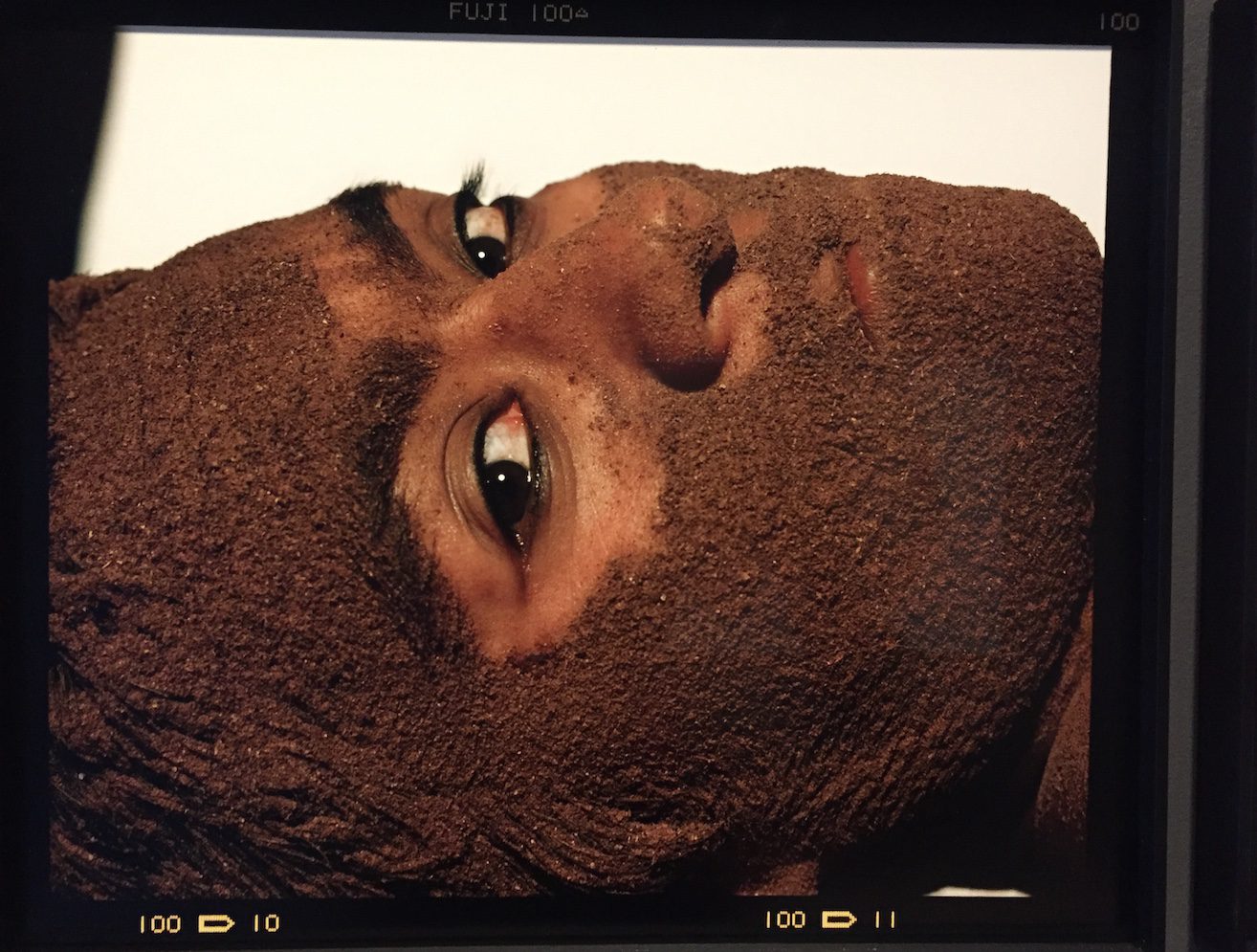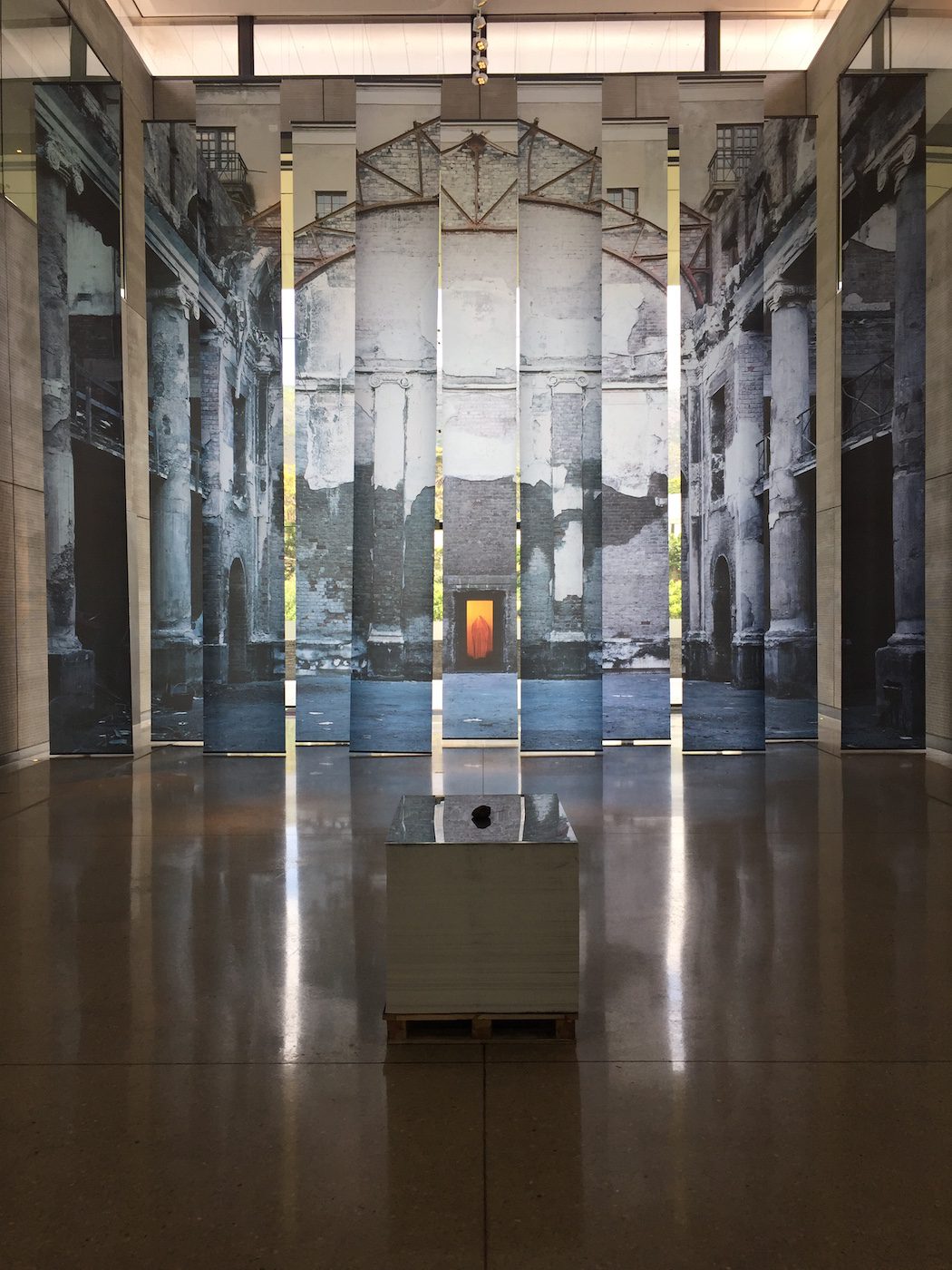Une rétrospective examine avec soin les thèmes de prédilection de Berni Searle – les ruines, les traces et la perte, comme terrain particulièrement légitime pour méditer sur la libération.

Berni Searle, Untitled (red, white, yellow, brown), (detail), 1998. Installation view at Norval Foundation. Photo: Vusumzi Nkomo
Dans le hall de la Norval Foundation se dresse une œuvre dense en deux parties : un tas de papier empilé sur une palette de bois qui supporte le poids, ou plutôt la légèreté, d’une minuscule pierre noircie à l’aide d’un pigment noir reposant sur une plaque de verre. Face à ce bloc central de papier blanc taché est suspendue une photo fragmentée de la bibliothèque Jagger de l’université du Cap – représentée dans l’état de ruine laissé par l’incendie dévastateur de 2021 qui a détruit des bâtiments de l’institution. Au centre même de l’installation se profile un corps humain enveloppé d’un vêtement d’or dont l’éclat se reflète et se fond dans le vaste mur doré contre lequel il s’appuie. Cette scène et cette figure étrangement envoûtante sont l’expression de la préoccupation de l’artiste originaire du Cap Berni Searle pour les ruines et les traces.

Berni Searle, Having but little Gold, 2023. Installation view at the Atrium, Norval Foundation. Photo: Vusumzi Nkomo
L’exposition rétrospective de Searle à la Norval Foundation donne à voir l’immense envergure des œuvres des vingt-cinq dernières années, qui vont de la vidéo et la photographie à l’installation et la sculpture. Sur le plan des thématiques, la curatrice invitée Liese van der Watt a réuni des œuvres qui explorent les problématiques de la race, de l’identité, de l’histoire, du genre, du travail, de la richesse, du colonialisme, du traumatisme, de la violence, de la mémoire, de la migration, de la perte, de l’extraction et de la dépossession. L’exposition présente les œuvres les plus connues de Searle, dont certaines de la série Colour Me (1998–2001) ainsi que de Snow White (2001). D’autres plus récentes comprennent des estampes intitulées Mantle I (2021) ou encore des travaux de la série Into the dark (2014), et l’installation Shimmer (2012–2013), mêlant projections vidéo, sculpture et audio. L’exposition révèle une artiste aux prises avec des concepts et divers médiums, en perpétuelle évolution, même si un élément constant de sa pratique reste identifiable, tant sur le plan conceptuel qu’émotionnel.
Il est intéressant d’examiner les points de convergence et les divergences entre Snow White et Into the dark. La tension apparaît aisément à travers leurs références respectives à « l’obscurité/la teinte foncée » et au « blanc/la blanchité » dans les titres des œuvres. Ils me semblent suggérer, dans l’esprit de Fanon, une certain irréconciliabilité dans leurs articulations, tout en invoquant une interdépendance. Dans le second titre, la préposition « into » indique que l’obscurité est un lieu vers lequel on se rend, ou dans lequel on entre, bien que la raison pour laquelle nous, public, sommes enjoints à y pénétrer ne soit pas très claire, ni si l’obscurité est un lieu exclusivement habité par le corps, le sujet et le moi de l’artiste. Dans la vidéo à deux canaux Snow White, la majuscule du « W » suggère que ce qui est examiné de près concerne la position d’un sujet spécifique sur le plan historique et sa surreprésentation de soi en souverain ou Man – pour l’emprunter à Sylvia Wynter –, plutôt qu’une simple couleur. L’œuvre est emblématique d’une cruauté froide et d’un plaisir excessif en lien avec la souffrance noire. Dans la série photographique Into the dark, le sujet reste silencieux, passif et étendu dans sa posture mortifère ; nous ne sommes instruits de la destruction du corps (et de la psyché) que rétrospectivement lorsque nous lisons le sujet de l’œuvre : le massacre de Marikana de 2012. À l’inverse, dans Snow White, la violence est présente et insistante et semble s’abattre depuis un lieu indéfini et indéterminé, au fur et à mesure que le corps de l’artiste se recouvre de la farine qui lui tombe dessus. Dans les termes de la psychanalyse lacanienne, nous pourrions le désigner comme le lieu du grand Autre qui, sur l’écran de gauche, observe le sujet d’une perspective aérienne. Elle submerge et engloutit le corps. Même les moments de transgression et de refus, comme semble le suggérer Searle, sont conditionnés par cet espace de violence (blanche) et d’ordre ontologique et épistémologique (blanc).

Berni Searle, Untitled (red, white, yellow, brown), 1998. Installation view at Norval Foundation. Photo: Vusumzi Nkomo
Tout au long de l’exposition, le corps, ou plus précisément, le corps de l’artiste, est empreint de significations extrêmement visibles, et est désigné comme « objet du regard », tel que l’a appelé Desiree Lewis, professeure d’études de genre et féministes, dans un texte sur Searle pour le journal Agenda en 2001. Ou, pour citer la théoricienne du cinéma Laura Mulvey, l’approche de Searle pourrait être lue comme « l’appel au regard ». Dans Untitled (red, white, yellow, brown) (1998), de la série Colour Me, une Searle calme et allongée regarde fixement le sujet qui la perçoit, dans un silence de mort. Ce mutisme résonne à travers la rétrospective et me rappelle la mise en garde de Lewis pour qui les figures de Searle sont prises dans une toile de significations violentes qui sont « extrêmement difficile à déloger » et qui signale un « legs du regard scrutateur ». Le regard de Searle pèse sur nous ; c’est peut-être ce que le philosophe Lewis Gordon appelle une « forme de vision illicite » qui nous atteint, nous invitant à être témoin. Toutefois, Lewis et le regretté artiste Mgcineni “Pro” Sobopha ont plaidé pour une forme de potentiel transformateur dans l’œuvre de Searle, Sobopha affirmant dans Agenda en 2005 que Searle « démystifie et fracture notre compréhension non seulement de la couleur, mais crée aussi de nouvelles significations ».
Le mutisme dans l’exposition atteint son point culminant dans une installation vidéo à deux écrans judicieusement intitulée Mute (2008), dans laquelle le sujet – Searle – n’est ni calme ni apathique mais privé de parole et de son. Son visage est inondé de larmes alors qu’elle lutte pour maîtriser ses émotions, suscitées par ce qu’elle regarde – ce qui nous apparaît être un écran de photogrammes situé sur le panneau opposé à la cabine de bois dans laquelle son travail est monté. Le texte de la paroi en vinyle nous apprend que Searle réagit aux attaques xénophobes (ou, plus précisément, afrophobes) par des Sud-Africains à l’encontre de ressortissants étrangers, principalement d’ascendance africaine. Mute révèle un gouffre dans le langage ; un fossé infranchissable qui marque l’espace entre l’articulable et l’inarticulable. Searle, son corps et ses gestes engloutis par la fumée et entrecoupés de croix noires qui flottent et brûlent, fixe des images en mouvement qui l’émeuvent jusqu’à la faire s’effondrer et pleurer. Abandonnée par les mots, il semble que, quelle que soit la terreur qu’elle observe (et dont elle ne peut se détacher), celle-ci ne peut être appréhendée qu’à travers les larmes. Je m’interroge toutefois sur le titre même de Mute : l’œuvre pourrait facilement devenir problématique et validiste en suggérant que les personnes qui ne peuvent parler, soit parce qu’elle n’ont pas la faculté de parler, soit qu’elles peuvent parler mais n’ont pas les mots, sont « muettes » ; cela semble réduire la distance, qui constitue une différence, entre ces deux sujets.
Pour terminer, Searle continue à se préoccuper d’un problème particulier sur le plan historique : celui d’une perte structurelle qu’elle cartographie et retrace du Cap à Marikana, du Congo à la Belgique, à l’île Maurice, en Arabie Saoudite, dans le détroit de Gibraltar entre l’Espagne et le Maroc, ou dans l’ancienne Gold Coast d’Afrique. Pour Searle, l’espace de la perte psychique, personnelle et politique est, en ces temps troublés, le seul terrain légitime où les méditations sur la libération puissent avoir lieu.
Having but little Gold: Berni Searle est à voir à la Norval Foundation au Cap du 15 février 2023 au 13 novembre 2023.
Translated by Myriam Ochoa-Suel.
More Editorial